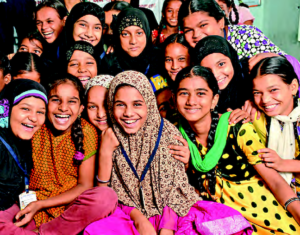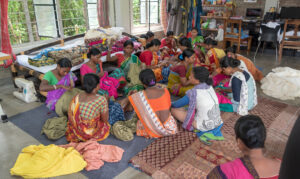While Aditya Birla Group (ABG) is widely acknowledged as one of India’s most trusted brands, not many would know much about its long-standing commitment to social welfare, primarily because this billion-dollar conglomerate does not go to town on what it actually does. Take Covid relief for example: while some celebrities and consumer brands were engaged in public relations exercises and generating social media frenzy for even donations worth a few lakhs, ABG silently donated Rs 400 crore to the government and reserved another Rs 100 crore for the fight against the pandemic. Of greater import in terms of impact and scale is the ‘model village’ concept that the Group has been tirelessly working on and translating into reality over the past decade, not only reimagining the future for India’s rural majority but in the process also creating a prototype for others to adopt and implement.
Most of the social development initiatives of the Group are conceptualised and managed by the Aditya Birla Centre for Community Initiatives and Rural Development, which is its apex body responsible for development projects. The centre is chaired by Padma Bhushan Mrs Rajashree Birla, affectionately known as ‘bard’ of the underprivileged. In all, the Aditya Birla Centre engages in multiple activities in more than 7,000 villages, touching the lives of more than 9 million people across India as also in other countries, in ways that are strengthening the basic fabric that holds communities together in a self-sustaining, vibrant, unique ecosystem.
The Centre also manages the Group’s corporate social responsibility (CSR) initiatives that are led by Dr Pragnya Ram, a much-admired name among the media, communications and CSR fraternity in India. Dr Ram leads a workforce of 1,200 professionals who have been implementing impacting social programmes at the grassroots and helping bring about the change that the Group’s founders had envisioned a few decades ago.
Model villages
The vision and the goal of Aditya Birla Centre for Community Initiatives and Rural Development are defined in the name itself. Rural India can develop only when its villages see progress and prosperity – when these transform into model villages – and it is this knowledge that drives the flagship programmes of the Centre.
The seeds of this ambitious programme were sown more than a decade ago, when the Centre had handpicked 300 villages from a total of over 7,000 where one or the other of their social interventions was already in place.
‘Beyond business, our CSR teams work to make a life-changing difference to 9 million underprivileged people globally. The project that I feel is the most inspiring is the model village project in rural India. Our teams have tackled issues that include female foeticide and dowry, in a deep and meaningful way.’
Kumar Mangalam Birla
Chairman, Aditya Birla Group
 The fundamental objective of these multiple interventions within the same village for the same community is to gradually ensure sustainable livelihoods for all. The Centre’s programme has proven that when villages overcome their initial growth obstacles, and when their basic necessities such as livelihoods, water and power as well as education and healthcare are taken care of, the socioeconomic development continues to happen organically. Eventually there comes a stage wherein the panchayats or the village committees become sufficiently empowered and efficient to be able to manage the village independently. That is the stage when it can be declared as a model village.
The fundamental objective of these multiple interventions within the same village for the same community is to gradually ensure sustainable livelihoods for all. The Centre’s programme has proven that when villages overcome their initial growth obstacles, and when their basic necessities such as livelihoods, water and power as well as education and healthcare are taken care of, the socioeconomic development continues to happen organically. Eventually there comes a stage wherein the panchayats or the village committees become sufficiently empowered and efficient to be able to manage the village independently. That is the stage when it can be declared as a model village.
How?
In case you did not know, there are a few criteria from the central and state governments as well as from some international organisations for a model village. Interestingly, 128 of the 300 villages (in 22 states) that the Aditya Birla Centre is working in already meet those basic parameters.
Better education
Talking about measurable numbers, the average literacy rate in the Centre-supported villages is 84 per cent, which was just about 60 per cent prior to the education-focused interventions. None of the villages has any out-of-school child, a drastic change from the 52 per cent enrolment rate a few years ago. The average dropout rate is two per cent, mainly on account of transfers and other such unavoidable circumstances.
Improved healthcare
The healthcare indices are equally promising. Child malnutrition rates have dipped below five per cent, and 100 per cent children across all villages have received all necessary immunisations. Against the national average of 28 deaths per 1,000 live births, these model villages report a zero child mortality rate. Also, as villages maintain an average of 90 per cent institutional deliveries, they have maintained maternal mortality rate below one per cent.
Sustainable livelihoods
 The average household income across villages has seen a rise of 40 per cent (ranging between Rs 10,000 and Rs 28,000) in the last few years. This has been possible due to multiple reasons, the primary ones being efficient land irrigation as well as cultivation of waste land and multiple cropping techniques that resulted in an approximately 30 per cent average rise in production of crops. Likewise, access to professional veterinary services ensured better cattle health and higher milk production.
The average household income across villages has seen a rise of 40 per cent (ranging between Rs 10,000 and Rs 28,000) in the last few years. This has been possible due to multiple reasons, the primary ones being efficient land irrigation as well as cultivation of waste land and multiple cropping techniques that resulted in an approximately 30 per cent average rise in production of crops. Likewise, access to professional veterinary services ensured better cattle health and higher milk production.
Skilling-focused interventions in the same villages have ensured that about 72 per cent of the youth are employed and earning. More women are now part of self-help groups. At present, more than 2,000 women from the beneficiary villages are a part of 175 self-help groups.
Responsible governance
Empowering women is one of the essential aspects underpinning all of the Centre’s village development projects. It starts with ensuring that women participate in every decision that is made for the community. The Centre’s programmes over the years have encouraged women to engage in panchayat activities and now over 25 per cent of women are active sarpanches as compared to just about 4 per cent a few years ago.
Sociocultural change
While the indices on the education and healthcare fronts are praiseworthy, it is the social change and the stories of communities who have overcome social evils such as female foeticide, child marriages, dowry, and addictions that reflect the fundamental shift that has happened in these geographies.
All the model villages are in the vicinity of the plants or areas of operations of Aditya Birla Group companies such as Grasim, Hindalco, UltraTech, and Aditya Birla Fashion & Retail, and are being supported under their corporate social responsibility (CSR) mandate.

